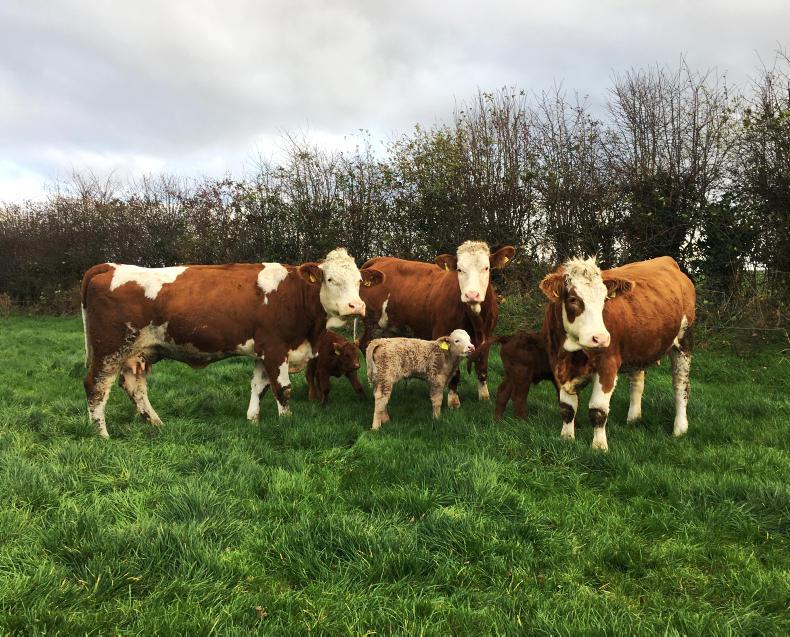Thankfully, the annual herd test is over for another year and all is clear. I was a small bit apprehensive, as a few of my cows had developed lumps after their clostridial vaccination back in the spring.
For some reason, it is common enough for the blackleg vaccination to cause lumps, but I didn’t like going into the herd test with lumps already on the cows.
With the best will in the world, mistakes can happen and all it would take is for one of these lumps not to have been seen the first day of the test and misread the second day see a reaction and the herd could be locked up.
Thankfully, I had my vet well warned of the situation and he was very on the ball.
Calving
Calving has grinded to a bit of a halt at the minute, with only one cow calved in the last two weeks and nothing else really showing any immediate signs. That can obviously change in a matter of days.
Hopefully, they won't all start spitting them out over Christmas and I’ll get a couple of lazy days at least. In fairness, I don’t know how lazy they’ll be with three young children running around - hectic might be a better description!
It's still nice to have the reassurance of the bull there to mop up
I’m nearly at the end of the AI-bred calves, maybe a couple more, but everything else will be out of my Charolais stock bull. I’ll have this bull two years in March and I don’t know if he came to a good home or a bad one, because I’d say he’s only bulled 10 or 11 cows in those two years - everything else has been bred to AI.
It's still nice to have the reassurance of the bull there to mop up. After a couple of months watching cows for heat detection, one’s enthusiasm tends to wane.
Beef conference
I attended the National Beef Conference in Claremorris last week. It had some good topics and speakers and some stuff that we’ve heard before, but, all in all, a worthwhile enough event.
Dr Donagh Berry put forward an interesting presentation entitled 'The genetics of meat eating quality'.
He stressed that meat-eating quality characteristics such as tenderness, juiciness and flavour are becoming increasingly important in maintaining demand for beef products and while there are difference in eating quality between breeds, up to 15% of the within-breed differences are due to genetic differences.
Put simply, if we know what genes are needed to produce high meat-eating quality, we can ensure that we only breed from animals carrying these genes.
Read more
Contrasting fortunes for live and dead trade
Monday management: time for pre-calving minerals
Thankfully, the annual herd test is over for another year and all is clear. I was a small bit apprehensive, as a few of my cows had developed lumps after their clostridial vaccination back in the spring.
For some reason, it is common enough for the blackleg vaccination to cause lumps, but I didn’t like going into the herd test with lumps already on the cows.
With the best will in the world, mistakes can happen and all it would take is for one of these lumps not to have been seen the first day of the test and misread the second day see a reaction and the herd could be locked up.
Thankfully, I had my vet well warned of the situation and he was very on the ball.
Calving
Calving has grinded to a bit of a halt at the minute, with only one cow calved in the last two weeks and nothing else really showing any immediate signs. That can obviously change in a matter of days.
Hopefully, they won't all start spitting them out over Christmas and I’ll get a couple of lazy days at least. In fairness, I don’t know how lazy they’ll be with three young children running around - hectic might be a better description!
It's still nice to have the reassurance of the bull there to mop up
I’m nearly at the end of the AI-bred calves, maybe a couple more, but everything else will be out of my Charolais stock bull. I’ll have this bull two years in March and I don’t know if he came to a good home or a bad one, because I’d say he’s only bulled 10 or 11 cows in those two years - everything else has been bred to AI.
It's still nice to have the reassurance of the bull there to mop up. After a couple of months watching cows for heat detection, one’s enthusiasm tends to wane.
Beef conference
I attended the National Beef Conference in Claremorris last week. It had some good topics and speakers and some stuff that we’ve heard before, but, all in all, a worthwhile enough event.
Dr Donagh Berry put forward an interesting presentation entitled 'The genetics of meat eating quality'.
He stressed that meat-eating quality characteristics such as tenderness, juiciness and flavour are becoming increasingly important in maintaining demand for beef products and while there are difference in eating quality between breeds, up to 15% of the within-breed differences are due to genetic differences.
Put simply, if we know what genes are needed to produce high meat-eating quality, we can ensure that we only breed from animals carrying these genes.
Read more
Contrasting fortunes for live and dead trade
Monday management: time for pre-calving minerals






 This is a subscriber-only article
This is a subscriber-only article










SHARING OPTIONS: